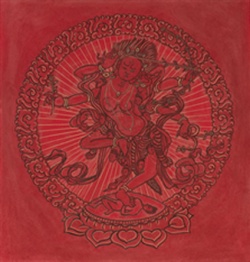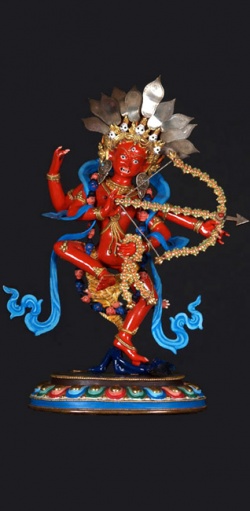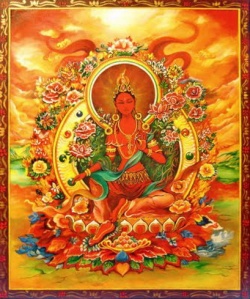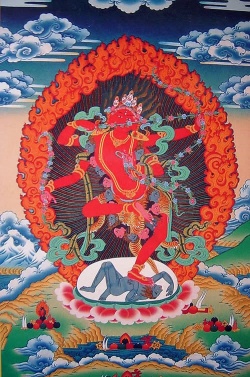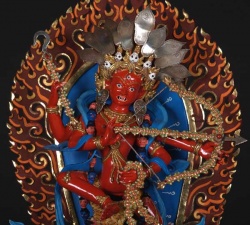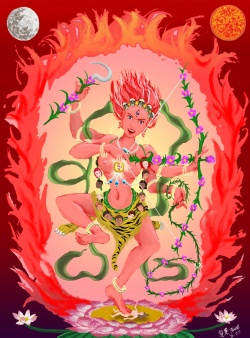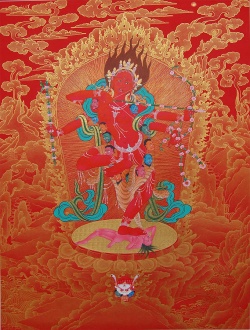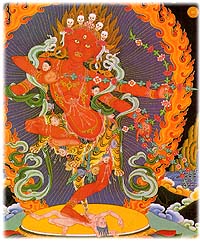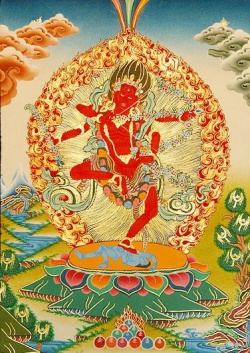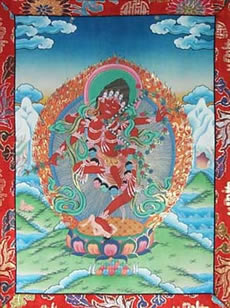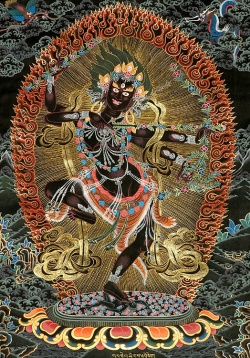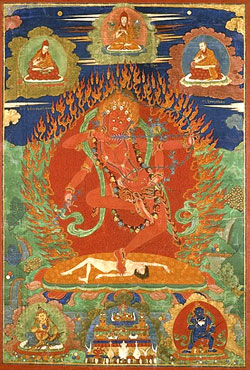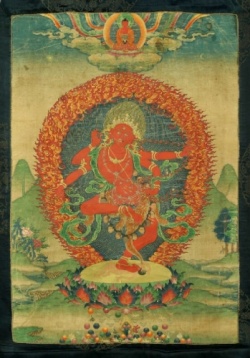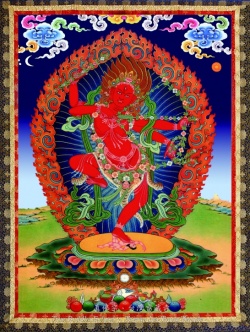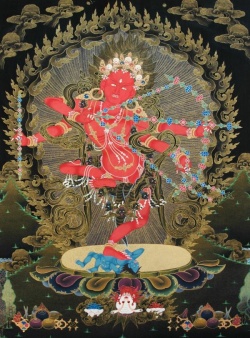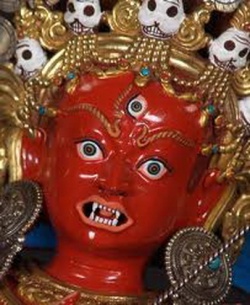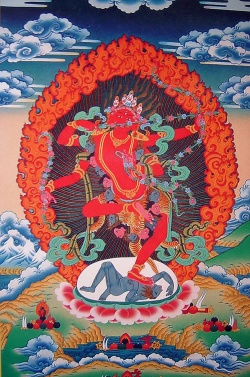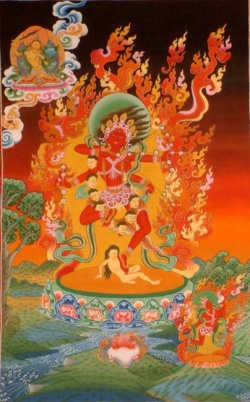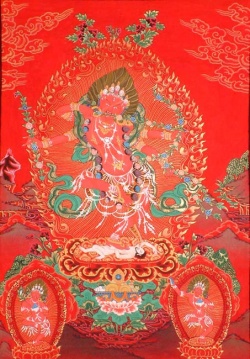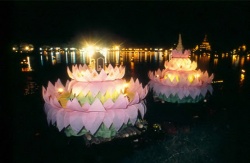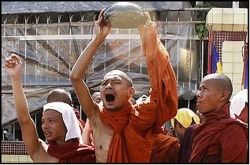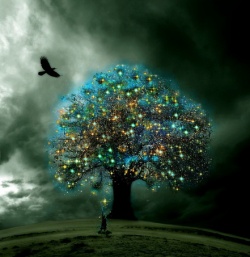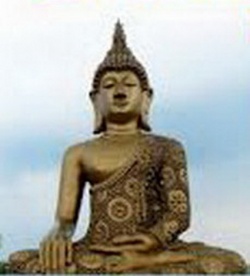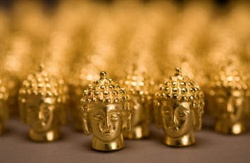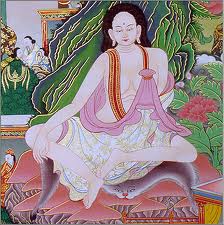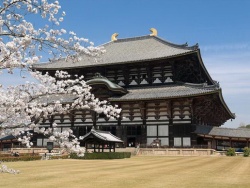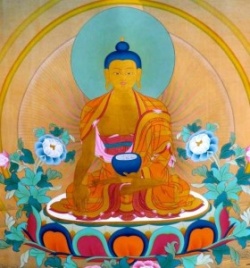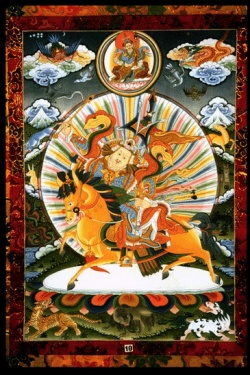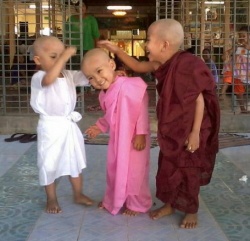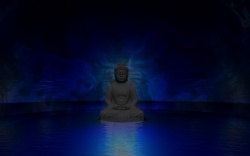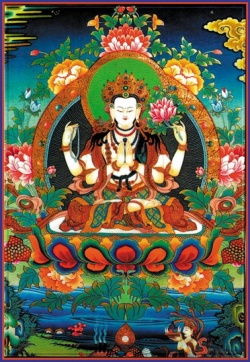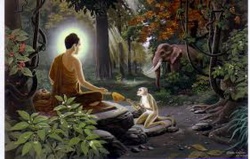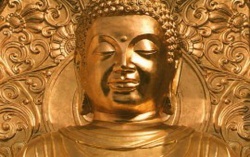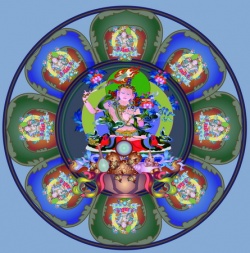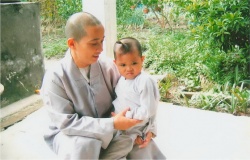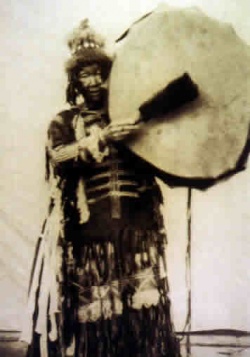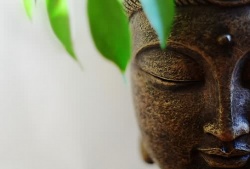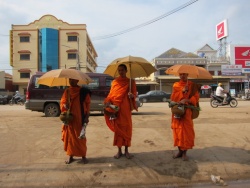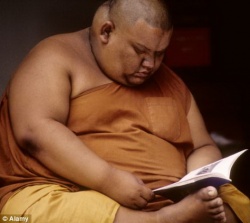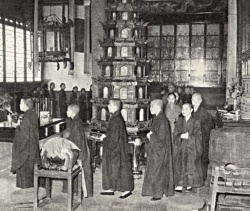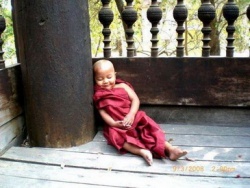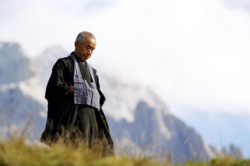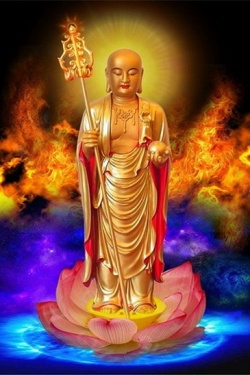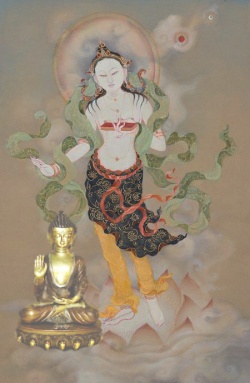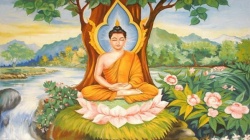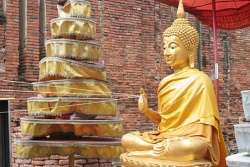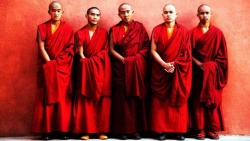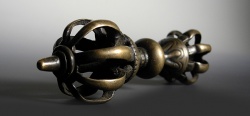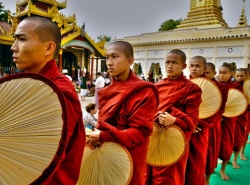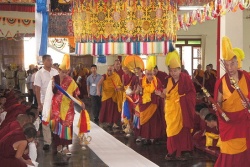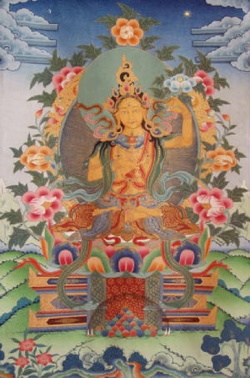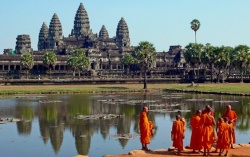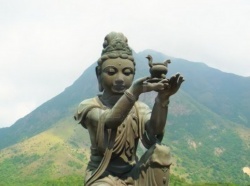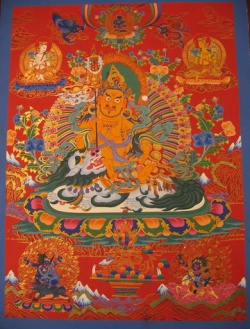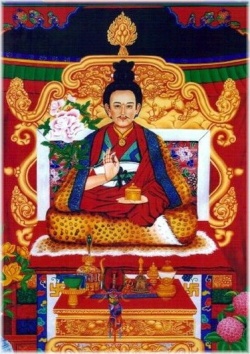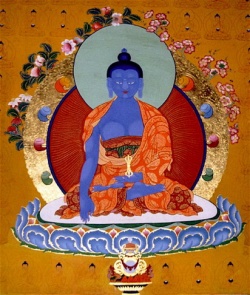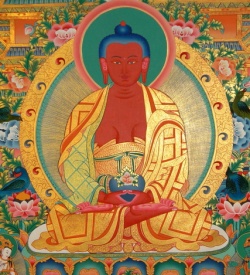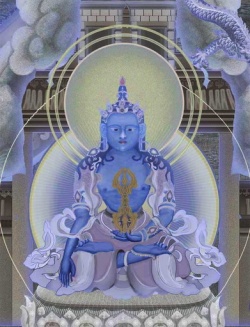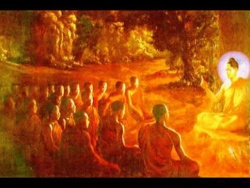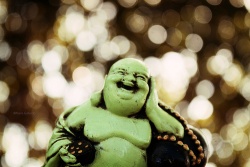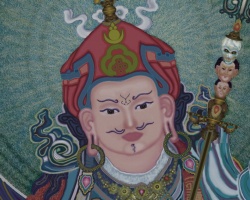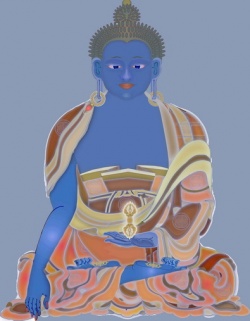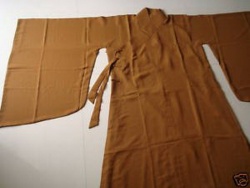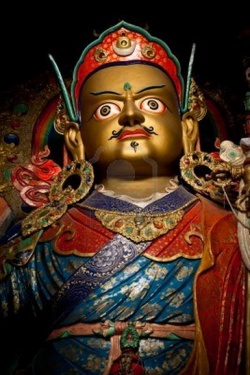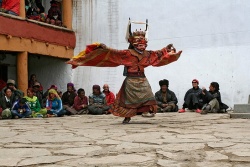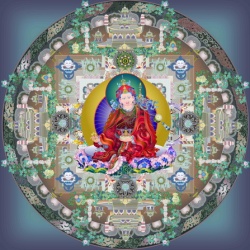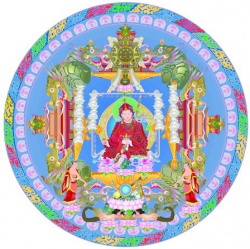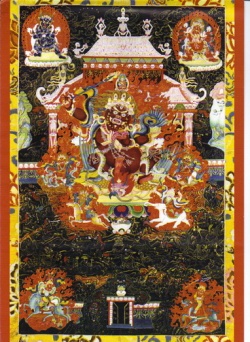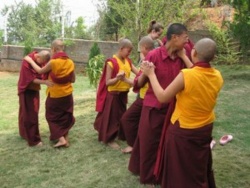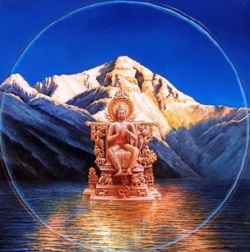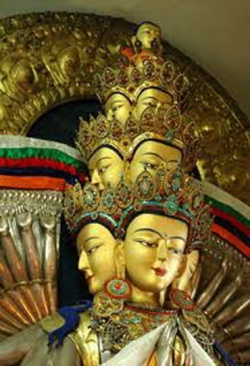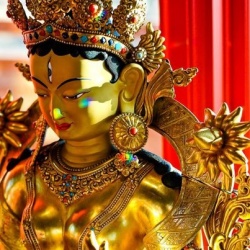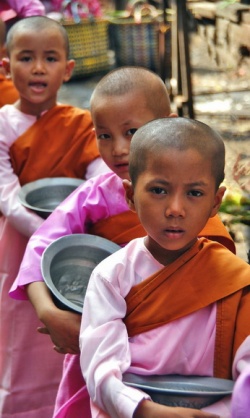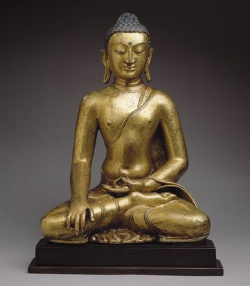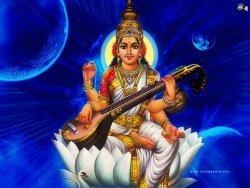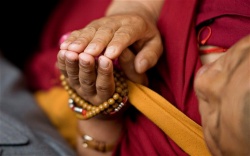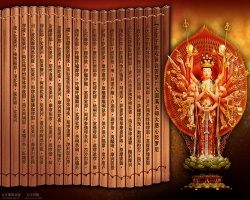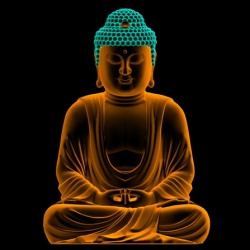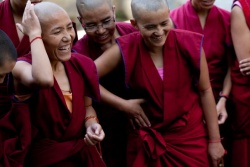The Practice Manual of Noble Tārā Kurukullā
འཕགས་མ་སྒྲོལ་མ་ཀུ་རུ་ཀུལླེའི་རྟོག་པ།
The Practice Manual of Noble Tārā Kurukullā
Āryatārākurukullākalpa
’phags ma sgrol ma ku ru kulle’i rtog pa
Toh. 437, Degé Kangyur, vol. 81 (rgyud ’bum, ca), folios 29b.1–42b.3
Translated by the Dharmachakra Translation Committee
Copyright: Published by 84000 (2011)
www.84000.co
Summary
The Practice Manual of Noble Tārā Kurukullā is the most comprehensive single work on the female Buddhist deity Kurukullā. It is also the only canonical scripture to focus on this deity. The text’s importance is therefore commensurate with the importance of the goddess herself, who is the chief Buddhist deity of magnetizing, in particular the magnetizing which takes the form of enthrallment.
The text is a treasury of ritual practices connected with enthrallment and similar magical acts—practices which range from formal sādhana to traditional homa ritual, and to magical methods involving herbs, minerals, etc. The text’s varied contents are presented as a multi-layered blend of the apotropaic and the soteriological, as well as the practical and the philosophical, where these complementary opposites combine together into a genuinely spiritual Buddhist work.
Acknowledgments
Translation by the Dharmachakra Translation Committee.
Translated by Thomas Doctor from the Tibetan of the Degé Kangyur, with continuous reference to an English translation and critical edition of the extant Sanskrit manuscripts by Wieslaw Mical. English text edited by Gillian Parrish.
Introduction
The very foundation of all Buddhist paths is the recognition of the unsatisfactory nature of saṃsāra, the cycle of conditioned existence, and the quest for liberation from it. Building upon that basis, the Great Vehicle holds that saṃsāra and nirvāṇa are indeed inseparable and that the goal of all practice must be the liberation from suffering, not only of oneself, but of all other beings. It is a debated point as to whether tantra has its own unique view. Where there is unanimity, however, is that the path of the tantras adds a panoply of methods that enable the practitioner to achieve the goal of the Great Vehicle swiftly and effectively.
The tantras are concerned principally with the stages of “deity yoga.” With the guidance of a skilled teacher and after suitable preliminary training and empowerment, the practitioner is introduced to, and subsequently trains in recognizing, the divine nature of the world and its inhabitants. This is symbolically centered on the generation of the deity as the embodiment of enlightenment in one of its many aspects—a depiction in terms of form, sound, and imagination of the very goal to which the practitioner aspires. Through various modes of such practice, which differ according to the different levels of tantra, the practitioner is able to recognize, access, and actualize his or her own innately enlightened nature.
The female deity Kurukullā, whose practice is the subject-matter of this text, has a particular place and orientation amid the pantheon of meditational deities. Like all deities, she is a personification of buddhahood in its entirety. As a female deity, she is understood to embody the wisdom aspect of enlightenment (i.e., emptiness), and as a form of the savioress Tārā, herself a manifestation of Avalokiteśvara, she personifies all-embracing compassion. But her particular quality is related to the “activity” of enlightenment. Many Great Vehicle scriptures describe the spontaneous and effortless activity of buddhas for the benefit of beings. In Vajrayāna that enlightened activity is spoken of in terms of four modes, or types, of activity: pacifying, enriching, magnetizing, and destroying. It is the third of these, magnetizing, that is the special field of Kurukullā, and it is to deploy that particular quality of enlightenment that a practitioner would undertake her practice.
While there are as many as thirty-seven Kurukullā sādhana liturgies included in the Tengyur, and many more in the indigenous Tibetan literature, the text translated here is the only work in the Kangyur that focuses on Kurukullā. Rather than being a systematic presentation of one form of practice, it takes the form of a compendium of varied elements—ranging from formal sādhanas to traditional fire offering ritual, and to magical recipes and methods involving herbs, minerals, and other ingredients—from which a practitioner might draw in order to constitute a range of Kurukullā-centered practices. The text’s varied contents are presented as a multi-layered blend of the apotropaic and the soteriological, as well as the practical and the philosophical.
The text’s pattern of contents is in keeping with the term kalpa figuring in the title. An ancient meaning, already found in the Ṛgveda, of the word kalpa, is “sacred rule” or “precept,” applying, in particular, to ritual procedures. As such, the scriptures that carry this term in their title are mostly ritual compendia or manuals of ritual practice. With the emergence of Vajrayāna a number of these works appeared, such as the Mañjuśrīmūlakalpa, the Kurukullākalpa, and the Vajravārāhīkalpa. As these titles might then suggest, they are ritual compendia for their specific deities.
The word kalpa derives from the root kḷp, which means “to prepare” or “to arrange.” This meaning is also reflected in the contents of the works that belong to this genre—they are primarily concerned with the technicalities of the ritual rather than with philosophical debate about the principles involved. This is, however, not to say that the latter is altogether absent. Genre-wise, kalpas are closely related to tantras, inasmuch as they are divinely revealed by the Buddha or one of the great bodhisattvas, such as Avalokiteśvara or Vajrapāṇi. Moreover, both kalpas and tantras are concerned with a particular deity, or set of deities, and aim to guide the practitioner in the rituals and practices related to that deity.
The Tibetan version of the Practice Manual of Noble Tārā Kurukullā is structured into five chapters, whereas the Sanskrit has essentially the same content structured into eight. Chapter One begins with the statement of its authenticity, and for this, the text declares that it is a direct literary descendant of the Tantra of the Arising of Tārā (Tārodbhava). These Kurukullā teachings, as found in our text, were given by Lord Avalokiteśvara on the Potala mountain, in response to a plea by a female audience consisting of different classes of semi-divine beings. Responding to their request, Avalokiteśvara begins to explain Kurukullā worship and its requisites, which include the drawing of the deity’s image (Kurukullā in her four-armed, seated form), the eighteen-fold pūjā, the mantra and the gathering offering. The main three benefits of this practice are the ability to enthrall beings, to increase wisdom, and to remove poison.
These benefits all have a spiritual dimension if the practitioner possesses a bodhisattva attitude: with loving kindness he or she will be able to control wild animals, with compassion practitioners will deliver the entire world from pain, and by becoming identical with Tārā-Kurukullā, they will be able to provide assistance to beings in need. The practice of compassionate virtue is the key to this success.
In Chapter Two there follows a description of the sādhana of the wish-fulfilling tree, through which one makes offerings to the buddhas and provides sentient beings with all that they need. This sādhana of the wish-fulfilling tree is followed by the main sādhana of the Kurukullākalpa. It is introduced by the statement that the mind is the sole “reality,” and because of its being such, the key to attaining buddhahood is the cleansing of the mirror of mind. The means for this cleansing is this very sādhana. As it follows the formal structure of a typical yoginītantrasādhana with its prayers, worship, visualizations, etc., it is not necessary to recount here all the traditional details.
After summoning the “wisdom being,” one requests an empowerment (abhiṣeka, dbang), and along with the empowerment one is given the injunctions regarding the follow-up practice. The sign of success is that the lotus-mudrā formed with one’s hands at the end of the six-month practice period will burst into flames. By proceeding as described, the practitioner (sādhaka, sgrub pa po) will attain the three enlightened bodies and will thereby be able to enact the great deeds of the Buddha.
At this point in the text, there is an interruption in the description of the empowerment and of the samaya-pledges (which are resumed much later in the text), and we have instead a discourse, given by Vajrapāṇi, on the three enlightened bodies, followed by a Nāgārjuna-style exposition of the doctrine of emptiness. When asked how the mudrās, mantras, maṇḍalas and siddhis should be interpreted in the context of emptiness, Varjapāṇi explains that they too are part of the chain of dependent origination—i.e., that the accomplishments are achieved in dependence on the mudrās, the mantras and so forth.
Chapter Three begins with a section containing various methods and related information on the main types of Kurukullā activity—enthralling, increasing wisdom, and removing poison, with discussion of the deeper spiritual implications of these three acts. We are told what materials should be used as mālā beads for these three types of activity, and are given specific instructions on the lighting of sacrificial fires (the shape of the fire pit, the type of fire-wood, etc.) and on the substances used as offerings. Some methods further described involve medicinal plants and other materials. The teacher also points out the more profound purposes: by enthralling beings with the mind of loving kindness one can establish all of them in enlightenment, by increasing intelligence one can attain the perfection of wisdom and achieve liberation, and by removing poison one brings peace to the world.
Further, we are given instructions on the method of visualizing the syllable hrīḥ (the seed syllable of Kurukullā) on different parts of the body and told the benefits arising from that: if it is on the clitoris, then enthrallment will follow; if on the chest, wisdom will increase; if between the teeth, one will remove poison. Connections are explained between the removal of faults of the body, speech and mind, and the acts of enthrallment, removing poison, and increasing wisdom, respectively. There is also a connection between removing poison (in the spiritual sense) and increasing wisdom. When the poison of ignorance is neutralized, desire is pure wisdom. It is explained that the goddess Pāṇḍarā (implicitly identified with Kurukullā) is, in essence, desire. Her non-dual passion is, however, completely free from poison and thus none other than wisdom.
The section on these different methods ends with a description of other Kurukullā magical practices, mostly for bringing results other than the main three outcomes specified above. These include: a yantra for warding off snakes, amulets for enthrallment and protection, rituals for bringing wealth with the help of drawings or a cowrie shell (the latter is also said to help one obtain a kingdom or even win at dice).
In Chapter Four we return to the description of the empowerment and the samaya ritual. This includes the description of the Kurukullā maṇḍala and the divination wherein a flower is tossed into the maṇḍala. After the divination, the initiand is told to observe secrecy regarding his practice and is given the samaya injunctions. The practitioner is instructed to rely on red substances, abstain from non-virtue, accomplish all the qualities associated with the perfections (pāramitā, pha rol tu phyin pa), and respect and pay homage to all women.
Once the samaya has been received, the four empowerments are bestowed, using water from the four jars of “the arrow,” “the bow,” “fearlessness,” and “the lotus.” An offering maṇḍala is described, with eight pitchers containing precious substances, along with a “pitcher of victory.” The disciple, suitably attired, is ushered into the maṇḍala and taught a secret method to control the nāgas. The Kurukullā dhāraṇī is now given—a lengthy formula aimed at bringing rain and prosperity. Further methods involving interaction with nāgas are also described—for stopping excessive rain, for curing leprosy and snakebites, and also for magically summoning and enthralling nāga women.
Chapter Five contains three nidāna stories, which are accounts of situations that prompted the Buddha to give the Kurukullā teachings. The first story is about the Buddha’s son, Rāhula, who, while being “pulled” (i.e., subjected to a particular kind of magic) by a nāga, recites the Kurukullā mantra and is miraculously transported into the Buddha’s presence. Witnessing thus the power of Kurukullā’s mantra, he requests from the Buddha the Kurukullā teachings.
The second story is about Mahākāla and Hārītī. Mahākāla, not being happy in his marriage with the ill-tempered demoness Hārītī, neglects his duty to protect the teachings. The Kurukullākalpa is then taught to help Hārītī enthrall Mahākāla, and in this way, mend things between these two unhappy lovers. As this is successfully accomplished, great happiness ensues. The third story is about Rohiṇīkumāra, a boy who, although born with auspicious marks, is dull-witted. His father asks the Buddha about possible ways to increase Rohiṇīkumāra’s intelligence, and in response, Buddha teaches the boy the Kurukullākalpa. As a result, Rohiṇīkumāra acquires great learning and wisdom.
The next section treats of alchemy (applied in combination with the Kurukullā mantra), which, as may be expected, is meant to bring the accomplishments of sky-travel and longevity. Here we find instructions on: 1) producing a mercury preparation which will enable the alchemist to fly through the sky as well as give him the power to enthrall women, 2) producing silver using a specially processed mercury (this is meant to lead, eventually, to the ultimate benefit for oneself and others), and 3) attaining the accomplishment of longevity by employing special plant-preparations.
The last part of Chapter Five describes the magical use of herbs and other substances (in combination with the Kurukullā mantra), as well as amulets, yantras, and other practices, which may be described as magical. Some of these means include: an ointment protecting one from wild elephants; a paste, which, when smeared on shoes, will enable the wearer to walk on water; an incense for the well-being of monks; an ointment to stop children from vomiting breast-milk; inscribed amulets affording protection and bringing good fortune; an amulet to be worn on one’s forearm to bring wealth; an alms-bowl inscribed with the Kurukullā mantra which enables the owner to procure alms in a place where they are difficult to obtain; various methods of enthrallment; a method preventing miscarriage; methods ensuring easy childbirth; remedies for breast diseases; practices meant to prevent premature greying of the hair; a paste meant to help women secrete vaginal lubrication (for pleasurable love-making); a remedy for premature ejaculation; a method for putting out a fire by sprinkling it with wine; and enthrallment methods involving yantra. Other wished-for results include: obtaining a fine son, healing different types of fever, curing eye diseases, overcoming impotence and finding buried treasures. Finally, the closing passages of the chapter once more ground the text and its teaching in the compassion of Avalokiteśvara, and beyond him in the infinite activity of the buddhas throughout space and time.
The final colophon in the Tibetan text gives the names of its two translators: the Indian Kṛṣnapaṇḍita and the Tibetan Tsültrim Gyalwa (tshul khrims rgyal ba, 1011-c. 1068). The latter is also known as Naktso Lotsawa (nag tsho lo tsā ba), a prolific translator who met the Indian master Atiśa Dipaṃkāraśrījñāna (982-1054) at the monastic university of Vikramaśīla and followed him on his journey to Tibet. With Atīśa and Kṛṣnapaṇḍita, Tsültrim Gyalwa translated numerous classical texts of both sūtra and mantra.
This English translation was prepared on the basis of the readings of the Degé Kangyur found in the Comparative (dpe bsdur ma) edition. The translation emerged in a process of continuous reference to a critical edition of the extant Sanskrit manuscripts and an English translation from the Sanskrit already prepared by one of the collaborators in this project.[1] As the various Sanskrit manuscripts of the Kurukullā are not readily available and present important variants, we have decided to include the critical edition as an appendix to this translation.
While endeavouring to produce a rendering of the Practice Manual of Noble Tārā Kurukullā informed by the full range of available Sanskrit and Tibetan manuscripts and editions, we have nevertheless retained the primary objective of translating here the Tibetan text contained in the Degé Kangyur. Where the Tibetan text is open to multiple interpretations, the English translation follows the Sanskrit manuscripts whenever this can be done while staying within the field of meanings conveyed by the Degé text. In general, words in Sanskrit have been reconstructed on the basis of the Sanskrit manuscripts rather than the Tibetan transliterations. Where the translation diverges from the explicit message of the Tibetan manuscript, the discrepancies have been noted. There are numerous further instances where the Tibetan and Sanskrit texts differ. These can be appreciated through a comparison with the forthcoming annotated translation from the Sanskrit.
Chapter One[2]
Homage to noble Mañjuśrī, the youthful one.
Homage to the noble goddess, Tārā.
The tantra of The Arising of Tārā is an ocean of yogic practice.
Although its scripture and practice manual had declined and disappeared,
There was The Meditative Absorption of Tārā, chief among tantras.
Once that too became lost, this practice manual appeared. [I.1]
For the sake of many beings, and as a compendium to the tantras
That elaborately teach the yogic practices,
Lokeśvāra, Lord of the World, taught this manual of practice.
Listen, all bodhisattvas! [I.2]
This method that benefits all beings
Is based on seeing that the world is without refuge,
And tormented by the three types of suffering.
Receive this with great reverence! [I.3]
In order to pacify the concepts of the world,
All buddhas teach this manual of practice.
On the holy Potala Mountain, Mañjuśrī,
Padmapāṇi, Jaya, [I.4]
Sarvanīvaraṇaviṣkambhin, Sāgaramati,
Maitreya and others—the full gathering—
All heard these words of the Dharma,
Rejoiced, and bowed their heads to the ground in veneration. [I.5]
The children of the victorious ones mastered it and praised it;
They worshipped it with song, melody,
And various types of dance.
Yakṣas, rākṣasas, the world of ghosts, [1.6]
Various maidens, the heavenly bodies,
Thunderbolt bearers, lords of the earth,
Nāga girls who live in the billowing seas
Where they cast coquettish glances, [1.7]
The guardians of the nether world, and the daughters of the surasiddhas—these all worshipped.
Gandharva queens with eye-catching breasts,
Female knowledge holders, kiṃnarīs,
Himavat’s daughters, as well as others, all spoke in this way: [I.8]
“For us there is no refuge.
Yet this teaching of the Buddha is the refuge for those who have none.
Protector of those without a refuge, protector of the world, [F.30.a]
You engender bliss and great wonder about this teaching.” [I.9]
The Lord, hearing these words of the assembly,
Pronounced the secret mantra, which he himself mastered,
And upon hearing this king of mantras, all the females there
Experienced numerous forms of the bliss of final buddhahood. [I.10]
By the touch of the vajra their bodies released the juice,
And casting sidelong glances,
They impatiently stamped their feet on the ground.
Carried away by the bliss of passion, they let their juices flow. [I.11]
May the Protector observe this and dispense
Timely words to these celestial girls—
The mantra of Kurukullā that enthralls wandering beings—
And the practice of painting in combination with this mantra. [I.12]
When the Blessed One, the Protector of the World, had proclaimed his intent,
He, the Master of the World, began to teach the stages of the ritual:
The method for creating an image of Kurukullā,
The mere painting of which [I.13]
Brings fruition to the practitioner—
I will now explain in full.
Who can create the picture?
On which day of the month and at which hour? [I.14]
That I shall now explain
In accordance with the prescriptions of the Arising of Tārā.
The one who paints the picture
Should have reddish eyes, [I.15]
As well as red hands and feet,
Eyes like those of a bird, and the legs of a black antelope.
It is such a person who shall draw the Savioress.
In the first month of spring [I.16]
On the eighth day of Caitra,
Half-way through the second watch—
This is when the eyes of Tārā should be drawn.
The artist must eat the three sweets [I.17]
And abstain from fish, meat, and alcohol.
Always dressed in red,
He must be smeared with a red fragrant paste.
Having brought forth a mind of loving-kindness [I.18]
He should bathe at dawn in a sanctified location.
Then, having changed into a garment of three pieces,
He should correctly draw the Enchantress:
Single-faced, with elongated eyes, [I.19]
Four-armed and of the color of kunkuma,
Sixteen years old and displaying an amorous sentiment,
Puffed up with pride on account of her magical feminine charm. [I.20]
The canvas should be woven with a thread spun by a female of fair complexion. Both she and the weaver should eat milk-porridge.
Upon a lotus seat, wearing an upper garment of red cloth, jewel earrings and a jewel diadem, [F.30.b] she displays the mudrā granting fearlessness with her lower right hand, and with her second right hand holds an arrow that she draws to the tip of her ear.[3] In her upper left hand she holds a bow, and in the second left, a red utpala. Crowned by Amitābha, dwelling in a cave in the mountains, she is Kurukullā.
Below Kurukullā is Rāhu, and above him, Kāmadeva with his spouse. Above Kāmadeva there is a moon disc, and upon the moon disc a red lotus seat. On this seat one must paint the Blessed Lady with all her beautiful features, and then consecrate her image. In front of the painting, from the eighth through the full moon day, one should perform the eighteen-fold pūjā, and recite the mantra. This is the heart essence of Tārā:
- Oṃ kurukulle hrīḥ hūṃ svāhā
This is the mantra. Having done the preliminary propitiation consisting of 100,000 recitations, next, on a buddha-day in the month of Kārttika, Vaiśakha or Āṣāḍha, having bathed at dawn and observed the restoration of vows ceremony, the practitioner should offer a complete pūjā.
He should present a feast for the congregation of listeners, and next offer a feast with gifts for the community of those practicing the secret mantra of the Great Vehicle. Placing his right knee on the ground, and with his robe thrown over one shoulder, he should receive the desired accomplishments. He should salute and ask the pardon of the saṅgha of listeners and the community of those who delight in the Great Vehicle.
Having gone to the place where the painting of the Blessed Lady is displayed, this knowledge holder should, for the sake of the desired accomplishments, enter meditation and recite the mantra one hundred thousand times for each of its syllables.
With the first third, insight increases,
With the second third, enthrallment is achieved,
And with the final third,
The person will also neutralize poison. [I.21]
By mad and haughty women, and by the entire world,
This practitioner will be honored.
Because of familiarity with the practice, this mantra holder [F.31.a]
May do as he wishes with beautiful goddesses. [I.22]
The mere sound of his name will cause those of incomparable poison to flee,
And even those as brilliant as the leader of the hooded will become just like a fish.
Those who engage in recitation, by means of their power of speech,
Render speechless even the experts who posses the majestic power of spells. [I.23]
Holders of mantra, who ride elephants and horses,
Embraced by their beautiful consorts who clasp their necks—
These are conquered by the power of the best among mantra-adepts.
Their minds partake of the pleasures of perfect kingdoms. [I.24]spells
Rati from Kāmadeva and Pārvatī from Śiva;[4]
Similarly, Śrī from Nārāyaṇa, Śacī from Ākhaṇḍala,
The white Amalagīśvariṇī from Vācaspati, and Lakṣmī from the Sustainer of the Earth—
These they win by means of the mantra. [I.25]
Those who possess the mantra and meditate on the Blessed Lady
Will gain various treasures, gold, silver, earrings,
Garments and other such wealth.
Their minds will partake of whatever they wish for, without exception. [I.26]
Having taken the kingdom from the king, the fruit from the tree that transcends the senses,
And the waters from the nāgas, rivers, and oceans,
Absorbed in the mantra, they drink and eat while purifying through the mantra.
For people without the mantra, no enjoyment can be won. [I.27]
Wild elephants; best horses of noble breed;
Best snakes, hooded and venomous;
Crocodiles; water buffaloes; and rhinoceroses—
These they summon by the power of their mantra. [I.28]
If also they look with eyes free from wonder
The mantra-adepts will thereby see.
If with the eye of compassion mantra adepts regard the world,
Which is stricken by all sorts of suffering, [I.29]
They will become Tārā,[5] benefitting the world like the wish-fulfilling jewel.
The entire world will become of Tārā[6] and know peace.
Having overcome the demons, they bring down a rain of wealth;
As a wish-fulfilling tree, they grant beings whatever they wish for. [I.30] [F.31.b]
Having drawn to them all the riches of the lords of wealth without exception,
They give it away for the benefit of all beings.
Likewise, for the benefit of the destitute in the world
Tārā creates clothes, seats, homes, and parasols. [I.31]
For those suffering on islands, due to the wreckage of their merchant vessels,
Tārā creates boats, ships, and so on.
The yogins who meditate on this Tārā
Will first experience some suffering. [I.32]
Yet once that is over, such people
Will soon discover feasts.
Next they will acquire garments,
Just as they will meet with noble women. [I.33]
Then they will enjoy the betel.
That which they wish for will be obtained without asking.
Even if one is celibate,
One may engage with a woman of supreme, celestial birth. [I.34]
Those who take pleasure in killing sentient beings
Will not succeed in this discipline.
Those who delight in the ten virtues,
Chapter Two
Through the method of worship in accordance with the Dharma,
One will attain dharmatā
And oneself will become the dharmadhātu.
That shall now be correctly explained. [II.1]
Now follows the practice method of the wish-fulfilling tree:
One should visualize, arising from the syllable vṛm,[7]
A wish-fulfilling tree.
As a transformation of the utpala,
It should be visualized to the left. [II.2]
A rain of various riches
Falls from the middle of the sky,
And so fulfills wishes and desires.
The one who meditates like this becomes the Lord of Wealth. [II.3]
The sentient beings of the four continents
One must summon through light rays of the mind
And so generously provide them
With the gifts that consist of the seven jewels: [II.4]
The jewel of the foremost teacher,
The jewel born from the sea,
The jewel of a woman, the jewel of a horse,
The jewel of a sword, [II.5]
The jewel of an elephant—such jewels
Should be offered mentally to the buddhas.
The jewel of a woman, adorned with ornaments
And displaying abundant attractions, [II.6] [F.32.a]
Should always be offered to the buddhas
By those who wish for the fruit of buddhahood.
Through this all buddas
And knowledge holders will be achieved. [II.7]
Replete with his treasures
A foremost teacher, a lord of wealth,
Should be offered to the buddhas. [II.8]
By those who wish for the fruit of buddhahood.
When likewise the other jewels
Are respectfully surrendered
One will turn into Vajradharma
And so become the benefactor of all beings. [II.9]
This was the practice method of the wish-fulfilling tree.
All the buddhas are mind itself.
By mind itself one is liberated.
Bondage is broken by the mind,
Through mind one attains freedom. [II.10]
Apart from in the mind
Things and entities are not seen anywhere at all.
Hence, there is no perfection to be seen
Apart from buddhahood and all the accomplishments. [II.11]
The environments and sentient beings,
The elements and their derivatives,
Have been declared to be “mind only”
By those who possess the undefiled special vision. [II.12]
Therefore, one should make every effort
To cleanse the mirror of the mind.
Faults, which are by nature extrinsic,
Will gradually be utterly exhausted. [II.13]
From the first of the vowels
Arises a stainless full moon.
Meditating on mind itself as that moon,
One places upon it the seed-syllable: [II.14]
The fourth in the sibilant group
Is positioned atop the syllable of fire,
Joined with the syllable ī,
And adorned with the two skies. [II.15]
A multicolored light from that
Cleanses beings of their impurities,
And turns this billion-fold world, and other such universes, into the field of space.
Having entered the Kurukullā mountain [II.16]
It rouses Tārā, and as she is summoned,
She is made to be present before oneself.
The wise must then from the syllable
Send forth a great cloud of offerings: [II.17]
Flowers, incense, and lamps,
Perfume, food, and the like;
Gestures, garlands,
Theatrical shows, songs, and other such offerings. [II.18]
“The three jewels are my refuge;
I confess all my wrongdoings;
I rejoice [F.32.b] in the virtues of wandering beings;
I set my mind on the enlightenment of a buddha”— [II.19]
These words should be spoken three times,
After which one requests departure.
When the mind has been made to abide through love,
It should again be placed there. [II.20]
Having engendered a mind of compassion
One should as well bring forth a mind of joy.
Afterwards, one should regard everything with equanimity
In its condition of being “mind only.” [II.21]
Then, in order to discard the ordinary,
The mind must once more be emptied.
The five aggregates of the process of re-existence
Shall be consumed by the fire of emptiness. [II.22]
Oṃ śūnyatājñānavajrasvabhāvātmako ˈham [8]
For a while one should practice this emptiness yoga
And so bring the mind refreshing rest.
Recollecting the vows taken earlier,
One should once more focus on simply the seed-syllable. [II.23]
“An exclusive nirvāṇa
Would mean deceiving sentient beings.
How shall I liberate them
From the endless ocean of existence?” [II.24]
Contemplating thus, the one who possesses love
Will abandon the emptiness devoid of mind.
A mind that is of the nature of the field of phenomena
Must be brought forth through mind itself. [II.25]
By the Buddha’s blessing arises the seed-syllable,
And from that, that which is called an utpala.
On the utpala, there is a moon-disc
Arisen from the syllable a. [II.26]
On that moon, again, is the seed-syllable,
From which emanate rays of light.
Thereby all realms of the world
Are seen to be thoroughly purified. [II.27]
Once they are purified and illumined,
One should perceive that great numbers of buddhas
Melt into light and enter the seed-syllable.
From that arises Tārā. [II.28]
As explained, the goddess is of the color of madder rose
And adorned with all of the ornaments.
First one should develop the samaya form
And then summon the wisdom circle. [II.29]
This occurs in an instant.
The wisdom circle remains in front.
With the application of the samaya seal
They should enter by the open pathway. [II.30]
The palms of the hands are joined
And the two little fingers visualized.
The middle fingers are joined at the tips
And the ring fingers are between them. [II.31] [F.33.a]
The index fingers are joined to the middle ones
And the thumbs are bent below.
Having formed the samaya seal in this way
One must summon the circle and cause it to enter. [II.32]
With the following verses to the buddhas
One should request empowerment:
“Just as Bodhivajra offers
The great worship to the buddhas, [II.33]
So too, in order to protect me,
Please, now grant it to me, O Khavajra.”
With the so-called ‘empowerment of the Victor’
Locanā and the other four arise. [II.34]
“The consecration of a king with flowers,
Great ones, bestow that upon me.”
“The empowerment by the great vajra,
Which is venerated throughout the three realms, [II.35]
And which originates from the abodes of three secrets,
That shall be given by all the buddhas.”
As the buddhas empower Tārā
She becomes crowned with the Dharma. [II.36]
With red light of different hues
She illuminates the three worlds.
One who has obtained the jewel of empowerment
Will attain all accomplishments. [II.37]
By means of the described ritual
One must practice stably for half a year
And offer bali at the three times.
By means of this mantra, [II.38]
And through the ritual of cane or cakes,
One will obtain a sign during dream.
The sword, the accomplishment of the netherworld,
Invisibility, the extraction of essences, [II.39]
Anonymity, celestial realms,
Foot unguent, and eye ointment—
The signs will be seen in dreams
And the accomplishments themselves will manifest. [II.40]
If one becomes fond of these,
Minor accomplishments will be attained through Tārā.
Having become a universal monarch, one attains
The kingdom and the pleasures of the senses. [II.41]
For the one endowed with meditation and recitation
These are even attained in dream.
At the final moon among the six,
Recite delightedly for one night [II.42]
And form the utpala mudrā.
As one recites, it suddenly bursts into flames.
By the power of this mudrā
Brahma, Indra, Upendra, Rudra and so forth, [II.43]
Together with their spouses,
Are summoned and arrive enthralled.
From then on, one will be accomplished in every respect [F.33.b]
And be free from the bonds of saṃsāra, [II.44]
Just as a lotus will be unstained
By water soiled with mud.
When touched, quicksilver becomes many,
Yet when coalesced, it once more becomes one; [II.45]
Within the state of omniscience
The same is the case with the accomplished one’s mind.
When touched by perfected quicksilver
Copper turns to gold; [II.46]
Likewise, when touched by the perfected mantra
The practitioner of mantra will become the bodies of the Buddha.
They attain the station of the lord of the gods
And become lords of the triple universe. [II.47]
When born in the family of Buddha,
They become turners of the wheel.
They are born, go forth into homelessness,
Practice the difficult conduct, [II.48]
And as they also engage in the conduct of enlightenment,
They recollect buddhahood itself.
Likewise, they descend from the gods, manifest emanations,
Turn the wheel of Dharma, [II.49]
Attain the great nirvāṇa,
And depart for a cemetery.
Having left their bodies in the triple world,
The Victorious Ones, by means of the enjoyment body, [II.50]
Return again to the pure abodes,
And so the emanation body emerges.
By means of the procedures of books and paintings,
There is engagement with the dharma body as well.
Hence, the mantra, thereby established,
Has indeed been taught by the buddhas. [II.51]
All the blessed ones, the thus-gone ones, then addressed the great bodhisattva Vajrapāṇi, so as to examine his noble mind: “How, O Vajrapāṇi, could the buddhas, the blessed ones, who possess vajra bodies, who possess dharmadhātu bodies, possibly die at some location on earth?”
Vajrapāṇi, in turn, offered the following words to those buddhas and bodhisattvas: “The bodhisattvas have asked me this, ‘How could buddhas, who possess vajra bodies, dharmadhātu bodies, bodies of non-duality, possibly die at some location on earth?’” And he proceeded, “Listen, O bodhisattvas, the so-called nirvāṇa [F.34.a] means a passage to the realm of bliss.”
The bodhisattvas enquired: “O Vajrapāṇi, do the buddhas, the blessed ones, go to the realm of bliss after they relinquish the dharma body, or do they go to the realm of bliss by means of the enjoyment body, having left behind their emanation body? How could they depart, having left behind the dharma body?”
Vajrapāṇi spoke: “A person with magical powers, may employ magic for some specific purpose, and so also succeed in achieving that purpose. Likewise:
Accomplished since the beginning,
The buddhas engage in the act of accepting birth,
To provide for sentient beings,
When a universal monarch has gone beyond. [II.52]
When a buddha goes beyond,
A universal monarch appears.
In this world there is never a time
When both of them are absent. [II.53]
The Buddha, the best among those who walk on two feet,
Provided guidance to beings in need of guidance.
After having remained for eighty years,
He departed for the abode of the victorious ones. [II.54]
Having left behind their magical illusion of a buddha
They remain in great bliss, which is the palace of the victorious ones;
Within the perfect peace of great bliss
They abide in a form that is in all ways delightful. [II.55]
An agent, eternal and singular—
Thus the sages regard the mind.[9]
Yet it is taught that it is not of such an essence,
Rather, it is held to be composed of moments. [II.56]
The victorious ones will relinquish their bodies,
For those deluded because of holding on to a self,
And for those who always want things to be permanent—
So that they may be introduced to impermanence. [II.57]
Those who are of the nature of all things,
And whose minds know everything,
They cannot be definitively said
To be absent anywhere. [II.58]
Based on the relative truth,
And for those in this billion-fold universe and elsewhere who are in need of guidance,
The buddhas teach the Dharma
Throughout the extent of space. [II.59]
There is no real birth of a buddha,
Nor is there any real death of a buddha.
Where everything is of the same taste,
This is the nature of arising and ceasing. [II.60]
The buddhas are of the same body within the dharmadhātu, [F.34.b]
And they are free from the five obscurations.
The body of the profound and the vast—
It is as the essence of this reality that a buddha remains. [II.61]
Since neither is the case,
They do, from the beginning, not exist.
Since from the beginning they have not arisen
They do not arise and they do not cease. [II.62]”
The bodhisattvas said, “How is it, O Vajrapāṇi, that the buddhas, the blessed ones, the teachers of the three worlds, do neither arise nor cease?”
Vajrapāṇi spoke: “Now, O bodhisattvas, what do you think? Does the one who is the Buddha exist, or not exist?”
The bodhisattvas replied, “O Vajrapāṇi, buddhas neither exist nor do they not exist.”
Vajrapāṇi spoke:
“Indeed, it is the unborn that is born.
The born will never be born.
When investigated in terms of the ultimate
They are unborn since the beginning. [II.63]
Likewise, the dead do not die,
Nor does the one who is not dead.
The non-abiding does not abide
And the one who abides is not in need of abiding. [II.64]
If that which has not been born were subject to decay,
Or if the unborn were subject to arising,
Then a rabbit’s horn would also
Be subject to arising and cessation. [II.65]
If that which exists were to arise,
That which has arisen would arise once more.
Also, if that which does not exist were to arise,
The barren woman’s son would arise too. [II.66]
Therefore, everything is ignorance,
Formations that possess the three characteristics.
The worlds that possess the five aggregates
Are known as mere appearance. [II.67]
The bodhisattvas should understand the nirvāṇa that pertains to the buddhas, the blessed ones, through this reasoning.”
The bodhisattvas asked:
“When nothing is produced,
What are mantras, what are tantras,
And how does one visualize the maṇḍala?
How, then, is accomplishment gained?” [II.68]
Vajrapāṇi replied:
“Originating in dependence—
This is how things arise
Likewise, depending on mantras, mudrās, and so forth
The accomplishments are gained. [II.67] [F.35.a]
The accomplishments are relative,
And so are the transcendences of the Buddha.
Chapter Three
The progression of the ritual for reciting the mantra, Shall now be explained. By merely understanding it, The practitioner will reach success. [III.1]
Coral is used for enthrallment, Puṣkara removes poison, And with crystal insight will expand. These are to be used in three activities. [III.2]
In a pit the shape of an aśvattha-tree leaf, which is the pure nature of the place of birth, one should light a fire with wood from the aśoka-tree. One must then, in the prescribed way, perform one hundred and eight offerings of red lotus flowers. The fire should be obtained from the home of an actor. The offerings are to be smeared with the three sweets and presented together with the root mantra.
Next comes the diagram. One should draw a triangular maṇḍala on cotton smeared with the mark of the moon. Within it, one writes entreating words that include the names of the practitioner and the one to be won: “Let me succeed in attracting such and such a person!” As one enriches this with the root mantra, one should write with a paint of liquid lac, blood from one’s left ring finger, camphor, kunkuma, and musk.
If one wishes to increase insight one should, in the same pit as before, burn arka and karavīra with the sacrificial fire used for brahmin oblations. One should offer aṭarūṣaka leaves[10] or sweet flag ten thousand times.
For removing poison, one should light a fire in the same basin with wood of the sandal tree, and in that offer the flowers of the piṇḍatagara. Thus one will become a curer of all poison. One will heal the different pains and bring peace.
This is the rite of the gāruḍa knowledge tantra.
On the paths of the triple universe One will attract and engage with All those who are known as noblewomen By means of oblation and the diagram. [III.3]
Loving-kindness through looking with impassioned love— [F.35.b] It is through such a mind that one performs enthrallment. Having enthralled all beings, One establishes them in the enlightenment of the Buddha. [III.4]
This is the rite of enthrallment.
The so-called “knower of everything” Cannot be attained without insight. The one who wishes to attain it, Should therefore develop incisive insight. [III.5]
Through the practice of recitation and oblations One will encounter all phenomena. The mind that is pure, bright, and stainless— That indeed is the transcendent insight. [III.6]
The yogin will be liberated. The leaves of gṛhābhidhāna, Ṣaṭhī, liquorice Brahmāṇī, māgadhī, and honey— These are to be eaten. [III.7]
This is the ritual for increasing insight.
Next[11] there is honey with ghee, Cakrāṅkita, and the good root— By applying this to the place struck by the poisonous fangs, Or by drinking it, one will neutralize the poison. [III.8]
This is the medicine that overcomes poison.
Jārī and caṇḍālikā, Snehamallī and ghee, As well as dead intestinal worms— When eaten, these effect enthrallment. [III.9]
This is the medicine for performing enthrallment.
The removal of poison brings peace in the world; From the development of insight comes buddhahood. Turning the wheel of Dharma will be accomplished In an instant by the one who practices enthrallment. [III.10]
For accomplishing the benefit of oneself and others There is no other means within the Great Vehicle. The practice of a spell just once Will immediately be convincing. [III.11]
Thinking of the syllable hrīḥ at the vessel of frenzy Will cause women to drip. Thinking of it upon the tongue or in the center of the heart, Will engender insights. [III:12]
When meditated upon in relation to the bite of the fangs This beautiful syllable of Dharma Will destroy poison. This heart of Tārā conquers the three worlds— [III.13]
That should be understood by those who love.
As the negativities of speech completely disappear, one will be able to remove poison; when those of the mind disappear, insight will increase; and when the flaws of the body are exhausted, one will bring about enthrallment. [III.14]
Hence, since this world is attached to non-virtue, it does not gain accomplishment. Therefore, O sons of the victorious ones, you must act to benefit, and give up evil. By means of the specific gestures the faults associated with the body certainly disappear [F.36.a] and, through the mantra, so do the faults associated with the composites of the tongue. [III.15]
The faults associated with the mind fade away in those whose minds delight in meditation. With the joy of stainless faith, the cognitions of the body become unmoving—that is the time of the Buddha’s blessing. The one who sees with an eye free from evil and who possesses compassion will become king of the three worlds. With his power of merit superior because of generosity, he becomes the foremost on the surface of the earth, a benefactor endowed with diligence. [III.16]
Having given up laziness, and by means of wisdom, he will not experience even a bit of the suffering of hell. Therefore, one relies on the wealth of the compassion of the sons of the victorious ones, and on their diligent conduct. Perceiving the buddhas in the center of the sky, one regards the buddhas by the power of concentration. Even in sleep one should always perceive oneself to be surrounded by the buddhas. [III.17]
At the time of death the wise proceed to the summit of mount Meru; Buddhas riding in various vehicles— These are seen by the ones who are compassionate by nature. Doing evil produces the perception of the cities of hell. [III.18]
This is the tantra for purification.
Where there is desire there is poison And also insight is present there.[12] Therefore, how can Pāṇḍarā Be regarded as the queen of speech?[13][III.19]
She is indeed the curer of poison Abiding on the level of Hayagrīva.[14] Manifesting as the speech of the vajra of passion, She enthralls the three worlds. [III.20]
This is the practice of the tantra of the desire family.
Next follows another method:
Having created a triangular maṇḍala And, in addition, another triangle, The wise must, starting from Indra’s quarter, Write the syllable oṃ and so forth. [III.21]
The six seed-syllables are in the six corners, And the seed-syllable of Dharma is in the center. Placed within a phuḥ syllable, It should be drawn on the doorstep. [III.22]
This is the tantra for driving away snakes.
Now, to bring women fortune, another method shall be explained:
One should draw a lotus flower with seven petals and apply the seven syllables to it. In its center one should, according to the enthrallment-procedure, write the name of the person to be enthralled, [F.36.b] supported by a pair of hrīḥ syllables. One should draw this on birch bark, or on cotton with flowers, and make it into a charm that is to be worn on the upper arm.
The master will become the slave of a woman And kings will turn into servants. By means of the extremely pure and clean This mantra can be removed.
This is the ritual for enthrallment.
Next follows the diagram for protection:
One should draw a four-petal lotus,
And then, in its center, a moon. In the east one should draw an arrow, And in the south, a bow. [III.24]
In the west is a hand showing the mudrā of fearlessness, And in the north, one draws a lotus. In the central moon is the one to be protected Surrounded by the seven seed syllables. [III.25]
As for the outer perimeter, It is adorned with a garland of utpalas. Having drawn this on birch bark, One should wear it on one’s upper arm. [III.26]
Moreover, children, the old, and the young will be self-protected by the diagram.
If one desires the attainment of a lord, one should draw a citron and, in its center, a bow. Inside the bow, one should draw a jewel-shaped lotus-bud. In the center of the lotus-bud is the syllable jrūṃ, surrounded by the seven syllables. One should draw this on a golden tablet and keep it in the upper part of the house. One should surround it with an outer garland of lotuses, and, on the eighth or twelfth day of the month, using a jar containing five types of jewels, one should take it down. Having washed and worshipped it, one should recite the mantra one hundred and eight times. Within a year, one will become the equal of Kubera. Such a charm should be worn correctly.
Next follows another method: on a Tuesday, if one finds a cowrie shell lying with its face up, one should place it in the palm of the hand and recite the mantra one hundred thousand times. If one plays dice, one will be winning.
Taking up the cowrie one should recite the Kurukullā mantra one hundred and eight times. On the twelfth or eighth day of the month, one should perform ablutions and make offerings. Then one should wrap the shell in silk and wear it on one’s arm. [F.37.a] The one who does so will become a great master of riches. If one puts this shell in a box and hides it in the ground one will every day obtain a kārṣa’s worth of wealth.
This is the tantra on obtaining wealth, a kingdom, royalty, and the fruit.
This completes the third chapter.
Chapter Four
The mere seeing of the colored powder
Quickly brings about the attainment of buddhahood,
As one progresses through the stages of perception of the maṇḍala.
That shall now be explained correctly. [IV.1]
Four-sided and with four doors,
It is adorned with four arches.
In its center one should place the goddess,
In a bhaga form of good color. [IV.2]
In the east an arrow should be drawn;
And in the south, a bow;
In the west, a hand of fearlessness,
And in the north, an utpala. [IV.3]
All are in the border areas:
The vajra, the wheel, and so forth.
Wearing a red upper garment,
And with his face covered by a red silken cloth,
The disciple should enter there. [IV.4]
At this point the sattvavajrī mudrā should be displayed, a flower should be offered to the circle, and the words “praticcha vajra hoh” be spoken. Then, as the cover is removed, the maṇḍala is to be revealed. In the best case, the flower has fallen in the center. If it has fallen on the arrow, the student will be capable of performing the acts of enthrallment. If it has fallen on the giver of fearlessness, the student should study the removal of poison. If it has fallen on the utpala, it is the development of insight that should be studied. And if it has fallen on the bow, omniscient wakefulness is to be pursued.
At the time of the entry, the following should be declared: “You must not speak of this supreme secret of all the thus-gone ones in front of anyone who has not entered this maṇḍala. Your samaya vow would definitely degenerate. Having failed to avoid the distressful, you would certainly die and fall into hell.”
After that the samayas are to be given with the words, “The Three Jewels must never be abandoned…” and so forth, just as it is extensively taught in the tantra. The oath is to be administered with the following words:
“If any among the great samaya vows of the King of Dharma
Which you have received from me [F.37.b] should degenerate
The buddhas and bodhisattvas
Who engage in the supreme conduct of secret mantra [IV.5]
Will extract and consume
The great blood and the great heart.
I am the guardian of the Dharma;
Do not displease me. [IV.6]
You should always wear red clothes,
A red mala,
Vermillion powder,
Apply red perfume, [IV.7]
And adorn yourself with red jewels and the like.
With the mind of passion you must meditate,
Just as you must recite the mantra with a passionate mind.
The palaces are to be painted.
With red ocher or sindhura [IV.8]
Vermillion powder,
Saffron, red sandal,
Or coral powder—all of these are appropriate. [IV.9]
Karketa dust is used for the drawing.
Whether for oblations, the circle,
Or inauguration,
Red substances are always to be applied. [IV.10]
These are indicative of the saffron of the Buddha.
You must not kill living beings,
Not speak what is not true,
Not take what has not been given, [IV.11]
And not associate with another’s wife.
Three acts of the body,
Four of speech,
And three of the mind— [IV.12]
Give up these unvirtuous acts.
Dharma, material things,
Love, and fearlessness—
You must always practice this four-fold generosity. [IV.13]
If you possess nothing, be generous through acts of meditation.
Also, you must always display the four means of magnetizing,
Along with the body of the perfections,
The powers, and the masteries. [IV.14]
You must not look down on females,
Particularly not anyone by the name of Tārā.
Even a householder practitioner of secret mantra
May not take such a woman. [IV.15]
In a town, at a gate, in a market place—
Wherever Tārā resides—
In a high street, at a four-road junction,
At the side of a wall, [IV.16]
And in particular at a three-road junction—
You should always pay homage at such places,
Offer praise, and present great offerings.
Having made such places your dwelling [IV.17]
You should practice the mantra and so forth.
Seeing a woman whose name is Tārā,
Of white and red complexion and beautiful eyes, [F.38.a]
The yogin should respectfully [IV.18]
Pay homage to her in his mind.
Upon bandhūka flowers,
The karavīra-holder,
As well as other red flowers [IV.19]
The practitioner should never step.”
As the vows are given in this way
There is the clean and pure water of divine substance.
The disciple should be purified with the water in the four vases
And the water of mantra. [IV.20]
In the right order, the master should then
Wash him with the gestures of the arrow, the bow, and so forth.
First by means of the vase with the arrow, [IV.21]
And secondly, the one with the bow.
The third is the one with the hand of fearlessness,
And the fourth, the one with the utpala.
“Just as the Lion of the Śākyas received [IV.22]
From the buddhas and their offspring, the vajra holders,
The empowerment for the great kingdom,
So also do I empower you.
The very essence of all the buddhas, [IV.23]
That, indeed, you have found in this maṇḍala.
Beholding these colored powders
The buddhas are thoroughly delighted.
Here there is no death and disease, [IV.24]
No grief and no poverty.
Through this pure Great Vehicle
You will attain complete enlightenment.”
Empowered through the arrow and the other three [IV.25]
The disciple has been made a vessel for the Dharma,
And is, in accordance with the ritual,
To be granted the secrets. [IV.26]
First one should train in the method of warding off the nāgas.
- namo ratnatrayāya. namaḥ sarvabuddhabodhisattvebhyaḥ. namo ˈṣṭasarpapudgalāya. namaḥ samastebhyo buddhakoṭibhyaḥ.. tadyathā. oṃ hrīḥ hrīḥ hrīḥ sarvanāgānām anantakulānāṃ vāsukikulānāṃ takṣakakulānāṃ śaṅkhapālakulānāṃ karkoṭakulānāṃ padmakulānāṃ mahāpadmakulānāṃ kulikakulānāṃ varāhakulānāṃ puṇḍarīkakulānāṃ ghanakulānāṃ meghakulānāṃ jaladakulānāṃ jaladharakulānāṃ jīmūtakulānāṃ saṃvartakulānāṃ vasantakulānāṃ airāvatakulānāṃ kumudakulānāṃ kahlārakulānāṃ saugandhikakulānāṃ hana hana śareṇa bandha bandha cāpena tāḍaya tāḍaya utpalena bhītānām abhayaṃ dehi pralayakāla iva jaladhāram avatāraya varṣaṃ tān nāgān vaśīkuru kuru phuḥ kulāpaya kulāpaya phuḥ phuḥ, oṃ kurukulle hrīḥ hūṃ phaṭ svāhā phaṭ[15]
With this mantra, one should draw the maṇḍala with gaur dung. As prescribed, one should draw an eight-petal lotus with sandalwood paste and place on its petals, starting from the eastern one, Ananta and the others—the eight nāgas—using candied sugar and bdellium. When the moon is in the Rohiṇī lunar house, one should perform a hundred and eight recitations, offer incense to the nāgas, and make offerings. If it does not begin to rain, they should be washed with wine and tormented with the fire of khadira wood. Doing this will bring rain. However, if the nāgas do not send rain, leprosy will break out.
This is to be carried out by a knowledge holder who is a performer of rites. Afterwards, they should be gathered and released in a great river.
“May the gods send rain
And may the crops be excellent.
May the people prosper
And the king be in accord with the Dharma.” [IV.27]
Thus one should perform the dedication.
One who wishes to stop excessive rainfall should obtain a snake from a snake charmer, anoint it with sandalwood paste, and feed it milk. One should pronounce this mantra over it seven times, put it in a red, unbaked jar, and seal it with the great seal. Breaking the vase will make the rain stop immediately.
Later one should offer a feast for the gathering,
Or make offerings to the saṅgha of listeners,
And give food and drink to boys and girls.
Doing this will delight the nāgas. [IV.28]
If, when it rains,
One does not do this
The nāgas will be displeased
And so one will contract leprosy. [IV.29]
The king, along with his sons and queens, should bathe on the fifth day of the waning moon. They should obtain the root of pratyaṅgirā, blend it with milk or ghee, and having poured it into a silver dish, they should drink it. If the dish is offered to an ordained monk there will not be any danger from snakes for one year. Moreover if, because of its unvirtuous actions, [F.39.a] a snake does bite, the snake itself will die. Success comes with seven repetitions of the mantra.
Also, if one wishes to cure leprosy, one should, by means of this very mantra, neutralize a poison and then ingest it. This will cure leprosy.
If one recites the root mantra over water, and then uses that water to wash the wound from a snake bite, that will remove the poison.
Moreover, if one wishes to see nāgas, one should pronounce the mantra upon a red utpala petal one hundred thousand times for each of its syllables. The petal should then be tossed into a pond, or the like, that is inhabited by nāgas and blessed. This will make the females of the nāgas tremble. They will request orders from the practitioner: “What shall we do, O lord?” The practitioner of mantra should then request what he wishes.
This was the fourth chapter.
Chapter Five
Once when young Rāhulabhadra had gone to Rājagṛha to receive alms, he went to the Veṇuvana grove, and there descended into a long pond to wash his alms-bowl. While there, he, the son of Yaśodharā, was mistaken for a white ascetic and so was pulled into the pond. At that time the young Rāhulabhadra recited this spell. No sooner had he recited the mantra than—just as someone emerging from his house—he arrived in the presence of the Blessed One.
Having approached the Lord, he said, “Father, I have seen the power of the secret mantra which you have granted.”
The Blessed One spoke: “Where have you seen that?”
“In the presence of the nāgas. Therefore, I request that the Blessed One teach this mantra, so that other beings too may be protected by it.”
Then, at that time and at that occasion, the Lord dispatched Vajrapāṇi, and so benevolently granted this mantra and this manual of instruction to the listeners and the bodhisattvas, to monks and nuns, and to male [F.39.b] and female lay practitioners. Therefore, O children of noble family, the one who creates a sandalwood maṇḍala and reads this mantra and this manual of instructions will not be harmed by poison, will not die from poison, will have no fear of boils, eczema, leprosy, disease, nāgas, snakes, tigers and other beasts of prey, weapons, enemies, poverty, or untimely death. None of these will occur.
In order to protect the Teachings, the Lord gave granted Mahākāla the demoness Hārītī, whom he had nourished from his own alms-bowl. She however, was lacking in fortune because of her former bad deeds. She was not agreeable to Mahākāla, and so he did not stay with her, did not love her, and did not protect the Teachings either. She therefore became depressed, and in order to enthrall Mahākāla this Kurukullā compendium was taught. From then on, her fortune became vast and excellent. For that reason, O children of noble family, if you wish to enthrall sentient beings you should familiarize yourselves with this mantra and this manual of instructions.
It also came to pass that Sunanda’s son was born handsome and good looking, athletic and in possession of auspicious marks, and yet nevertheless dull-witted.
Sunanda therefore requested the Blessed One, “O Lord, my son was born handsome and good looking, athletic and in possession of auspicious marks, and yet nevertheless dull-witted. How, O Lord, may he develop insight? Lord, if this child becomes literate he shall become a protector of your doctrine.”
Upon hearing this, the Blessed One, with words preceded by mindfulness, [F.40.a] spoke this manual of practice and gave this mantra. As soon as he had done so, Sunanda’s son, Rohiṇīkumāra by name, acquired insight. By the twelfth year he was free from being intimidated by any of the treatises, as he was thoroughly acquainted with all of the crafts and arts. Therefore, O children of noble family, in order to accumulate great insight, you should study this very mantra and its manual of practice.
Then the Blessed One spoke of the magical power of sky travel:
Mercury free from the mountain defect[16]
One should properly obtain,
Place in a vajra hollow,
And grind with the world-protector. [V.1]
Again, one should grind with dharmarasa,[17]
With yavatiktikā
And the juice of ākhukarṇī [18]
For a period of three days. [V.2]
With the sap of vandhyā and kākolī,
The sap of bhāskara and vajra,
The juice of aviddhaśravaṇa,
And breast milk—with these it should be blended. [V.3]
Having washed this mercury
Seven times with acidulated rice water,
One should grind it, put it in an iron pot,
And cook it in a lump of vṛddhadāraka dough. [V.4]
A lump of kanaka flowers
One should certainly spin on the top and the bottom.
When the root mantra has been recited one hundred thousand times,
The mercury will revolve clockwise. [V.5]
Upon that which is infused with the sun of sulfur
One should recite the mantra,
And in an iron pot placed over fire
Pour a little through the method of pulverization. [V.6]
When the sulphur has melted slightly
Sky-leaf is infused and smelted,
Thereafter, subsequently gold
And mākṣika is infused. [V.7]
Then, silver and copper should be infused,
And, similarly, iron five times.
Everything else should be infused six times.
It will then become equal to the light of the sun. [V.8]
With one guñja of this,
An experienced person will transform a great quantity.
If a pala can be transformed with māṣā,
It should be known that the mercury has been perfected. [V.9]
Kept together with meṣaśṛṅgī
The vajra should be killed with the sap of snuhī.
The bodily products of a female musk shrew
Are to be infused [F.40.b] into the perfected mercury. [V.10]
When this has mingled with the mercury,
Emeralds and so forth are also to be infused.
The Kurukullā yogin
Should dissolve a pearl on account of the eye, [V.11]
Taking always just a small amount
He will take pleasure with a hundred women.
With just seven nights of practice
The adept will be flying through the sky. [V.12]
This is the tantra on the use of mercury for journeying in the sky.
Taking a ball of lead,
One places it in a vessel with bakula seeds.
Having placed it in a vessel with the blood dripping kañcu,
One places it in a red earthen vessel. [V.13]
Together with mercury
The lead will undoubtedly die.
It is mixed with one pala-measure
And afterwards with sixty palas. [V.14]
As one practices, correspondingly,
A lump of silver will be produced.
As Tārā grants the accomplishment of silver
One is able to benefit sentient beings.
With the welfare of sentient beings comes the accumulation of merit,
And from that accumulation, complete enlightenment. [V.15]
This is the tantra on silver practices.
Nīlakroṇṇa flower, as has been explained,
Is known as the blue citraka.
For a month, the yogin should drink this with milk;
His life will extend for one thousand years. [V.16]
Having obtained the black through the speech of the mantra,
The yogin should place it in a bamboo vessel.
If he practices on the eighth day of the lunar month
He will live for as long as the sun, moon, and stars. [V.17]
Having obtained honey and turmeric,[19]
One should mix it with milk, and drink it.
One’s lifespan will without doubt
Be equal to that of the priests of Brahma. [V.18]
Likewise, having obtained the banana-like
Fruit of the banyan tree,
Wherever that may be,
If on a day of fasting
One mixes this with milk, and drinks it
One will be free from white hair and wrinkles. [V.19]
This is the tantra on essence-extraction.
While observing the practices, the one who desires a son
Should drink milk with the flowers of the baka tree.
If his spouse drinks this while fasting,
They will receive a fortunate son. [V.20]
With this mantra, the vacā fruit should be mashed
And mixed with milk.
When a fasting lady drinks this, [F.41.a]
She will gain a son with the characteristics of a king. [V.21]
She who, having washed with milk, drinks the root of lakṣaṇākṣa
Will obtain a fine son.
Resembling Siddhārtha, with perfect physique,
He will be undaunted by weapons and treatises. [V.22][20]
Having uprooted the jalaśītalā plant,
Or having obtained its root,
One consecrates it seven times with the mantra and binds it to the hair.
For one year this will prevent infectious disease. [V.23]
When, having obtained the root of kanaka,
The yogin places it in the hair of someone
Who suffers from the quartan fever.
That person will be relieved from his plagues. [V.24]
Brick, smoke, wine, acidulated rice water,
Along with the essence of the double-ra-king
Should be placed on a copper plate and blended with the milk of a woman.
When applied to the eye it will cure diseases of the eye. [V.25]
Having pulled out the root of a white uccaṭa plant,
Once consecrates it with fifty recitations of the mantra.
Drinking it with milk, as much as one likes,
Will render the fine mark of a powerful man fit. [V.26]
That which is well known as nagasala,
Generates, when mixed with milk,
The male organ’s power to produce plentiful offspring
Subsequent to fifty recitations of the mantra. [V.27]
Orpiment of bovine origin, tongue of a toothless man,
And the roots of nṛparāja—when the moon is in the Śubha asterism,
A tilaka should be drawn on the forehead.
Upon sight, the tilaka will enthrall the triple world. [V.28]
Having obtained a dead body’s eyes, heart, and tongue,
Forehead and likewise nose,
When the moon is in the eighth lunar mansion,
Frying these in sesame oil will make one the enthraller of people. [V.29]
The eye unguent of the king of snakes,
The remedy of bad eyes, the blood known as “the flower”—
If such medicine is applied to one’s eyes
It will seduce the king’s queen. [V.30]
If, having recited the mantra fifty times, one places one’s foot on the ground
In pursuit of treasure within it,
And the foot thus put down then vibrates,
It should be understood that a treasure is present there. [V.31]
If the upper part of the foot twitches, it is nearby; [F.41.b]
If it is the sole that twitches, it is far away.
Relying first on hearsay,
The knowledge holder should look downward every day. [V.32]
Whoever applies the excrement of the musk shrew
Together with bdellium will, merely by doing so
Stay clear of mad elephants
And emerge delightfully. [V.33]
If the milk of an entirely black bitch,
Having been churned, yielding fresh butter,
Is applied to shoes made of camel hide
Then wearing those will make one walk on water. [V.34]
When the thorns of yellow saṃkuca are gathered
And hidden in the wilderness home,
If the wine is broken, and then it is taken out,
That one will become truly excellent. [V.35]
If the fire that burns a potter’s wares
Is fed with a log struck by lightning
It will not burn,
Yet if sprinkled with alcohol it blazes again. [V.36]
Reciting the mantra, taught before, upon the stock,
And so teaching the consecration through mantra to merchants,
The yogin accomplishes the sales
And the merchants win great profit. [V.37]
If in a vessel for wine
Monkey feces have entered
The wine and the vessel are ruined.
Washing with bakula will render it usable. [V.38]
If washed with bakula water
The baby will be cared for by the nanny.
So too, through bhūtakeśa incense,
The saffron robed will be healed. [V.39]
If a child vomits breast-milk
The ashes of burnt peacock feathers
Should be bound to its neck;
Through this supreme method it will be healed again. [V.40]
When the ritual of yadakabaka
Is inscribed on a piece of lead
And kept inside the mouth
One will escape weapons, bondage, and enmity. [V.41]
Possessing the letters kṣa, ma, ra and ya,
All the letters are adorned with e.
At the end of the authentic kabaka,
The four eggs and the three measures are each given two. [V.42]
Daṇḍotpala, śarapuṅkha,
Nicula, and girikarṇikā—
Having washed it seven times with the juice of these,
The wise should write on a tablet of lead. [V.43]
Yokes, shackles, prisons,
The rain of weapons on the battlefield,
And also anger—these are definitively crushed [F.42.a]
Through the perfection of this great tantra. [V.44]
The one who writes this king of mantras,
Makes a spell of it, and wears it on the upper arm
Will become the equal of lord Kubera,
And attain treasures that cannot be taken away by others. [V.45]
Oṃ kurukulle svāhā—
When this is attached to the alms bowl
During a time of famine
The mendicant will receive donations. [V.46]
When the outer skin of an utpala stalk
Is washed with milk and drunk by a woman
She will, by her own actions,
Certainly maintain her pregnant womb. [V.47]
The five products of the māgadha,
When a woman grinds them and drinks them with milk,
The great power of this mantra
Will bring her ease in childbirth. [V.48]
Having ground a nimbavāruṇa leaf
And mixed it with the juice of vajra,
If a woman rubs this on her vagina at the time of birth
She will give birth with ease. [V.49]
Elephant-māgadhikā with sweet flag,
Horse-smell, and fresh buffalo butter—
The method involving vālā
Promotes the vitality of the breasts. [V.50]
A person who enjoys every type of food
And who drinks water through his nose
Prevents premature graying of the hair
By the application of the mantra. [V.51]
The root of avasanikā,
Kākamācī, and kanaka fruits
Ground with the sap of the camphor tree—
Applying this to the best part of the body will make tight women drip.[21] [V.52]
If at the time of intercourse a woman does not drip
She will not respect her husband, but want to leave.
So there is a wish for the gift of binding.
For the sake of dripping this ointment is applied. [V.53]
If at the time of sexual union
A lamp with lard is lit,
A man’s desire comes quickly
And he will remain in the vagina for long. [V.54]
When a house is set ablaze by lightning
If a man sprinkles wine by means of the mantra
The fire will die out.
This method was taught by the Protector of the World. [V.55]
Thus spoke the protector of sentient beings confined within saṃsāra,
The Protector of the World.
Upon Mount Potala, the king of mountains,
The Blessed One [F.42.b] was pained by the pain of others. [V.56]
“There is nothing at all that is not buddhahood.
For the sake of accomplishing the benefit of beings
There is nothing that has not been done before.
That which has degenerated, I intend to restore.” [V.57]
When the Blessed One, noble Avalokiteśvara, had spoken these words the full retinue, and the whole world with its gods, humans, demi-gods, and gandharvas rejoiced and praised the words of the Blessed One.
This completes the Practice Manual of Noble Tārā Kurukullā.
The translation was prepared, corrected, and established by the Indian preceptor, Kṛṣna Paṇḍita, and the lotsāwa monk, Tsültrim Gyalwa.
Bibliography
The bibliography contains the publications that we have referred to as well as background reading on Kurukullā and Tārā in India and Tibet. Information on the Sanskrit manuscripts consulted is given at the beginning of the critical edition.
- ’phags ma sgrol ma ku ru kulle’i rtog pa. Tōh. 437, Degé Kangyur, vol. 81 (rgyud ’bum, ca), ff. 29b.1–42b.3.
- ’phags ma sgrol ma ku ru kulle’i rtog pa. Tōh. 437, bka’ ’gyur (dpe bsdur ma) [Comparative Edition of the Kangyur], krung go’i bod rig pa zhib ’jug ste gnas kyi bka’ bstan dpe sdur khang (The Tibetan Tripitaka Collation Bureau of the China Tibetology Research Center). 108 volumes. Beijing: krung go’i bod rig pa dpe skrun khang (China Tibetology Publishing House), 2006-2009, vol 81, pp 127-169.
- Bandurski, Frank (1994). Übersicht über die Göttinger Sammlung der von Rahula Sankrtyayana in Tibet aufgefundenen buddhistischen Sanskrit-Texte (Funde buddhistischer Sanskrit-Handschriften, III). (Sanskrit-Wörterbuch der buddhistischen Texte aus den Turfan-Funden: Beiheft ; 5). Göttingen: Vandenhoeck & Ruprecht, 1994.
- Bendall, Cecil (1992). Catalogue of the Buddhist Sanskrit Manuscripts in the University Library, Cambridge (p. 178), 1992.
- Beyer, Stephan (1973). The Cult of Tārā: Magic and Ritual in Tibet. Berkeley, University of California Press, 1973.
- Bhattacharyya, Benoytosh (1958). The Indian Buddhist Iconography: mainly based on the Sādhanamālā and cognate Tāntric texts of rituals. 2nd edition. Calcutta, K.L. Mukhopadhyay, 1958.
- Bhattacharyya, Benoytosh (editor) (1968). The Sādhanamālā. 2nd edition. Baroda: Oriental Institute, 1968.
- Matsunami, Seiren (1965). A Catalogue of the Sanskrit Manuscripts in the Tokyo University Library. Tokyo: Suzuki Research Foundation, 1965.
- Mehta, R. N. (2005). “Kurukullā, Tārā and Vajreśī in Śrīpura.” In Tantric Buddhism: Centennial Tribute to Dr. Benoytosh Bhattacharyya, edited by N.N. Bhattacharyya. Reprint. New Delhi, Manohar.
- Pandey, Janardan Shastri (editor) (2001). Kurukullākalpaḥ. Rare Buddhist Texts Series, 24. Sarnath, Varanasi: Central Institute of Higher Tibetan Studies, 2001.
- Shaw, Miranda Eberle (2006). Chapter 22 in Buddhist Goddesses of India. Princeton: Princeton University Press, 2006.
- Snellgrove, David (1959). The Hevajra Tantra: a critical study. London, New York: Oxford University Press, 1959.
- Willson, Martin (1996). In Praise of Tārā: Songs to the Saviouress: source texts from India and Tibet on Buddhism’s great goddess, selected, translated, and introduced by Martin Willson. Boston, MA.: Wisdom Publications, 1996.
Websites
http://envis.frlht.org.in/indian-medicinal-plants-database.php
Sources referred to in critical apparatus, listed by the code letter(s):
Manuscripts
- Sanskrit manuscripts of the Kurukullākalpa:
- C – Shelfmark “Add. 1691/II”, Cambridge (UK) University Library; see Bendall 1992.
- G – Shelfmark “Xc 14/50 no. 4”, Göttingen University Library; see Bandurski 1994.
- J – “New 104” (“Old 198”); see Matsunami 1965.
- Y4 – “New 105” (“Old 203”); see Matsunami 1965.
- R – Running no. 5257, Asha Archives, Kathmandu
- Sanskrit manuscripts containing Kurukullā dhāraṇī (used only for the edition of KK (this document) 5.39):
- E1 – Reel E 1774/3 (multi-title), National Archives, Kathmandu
- E2 – Reel E 614/3 (multi-title), National Archives, Kathmandu
- Sanskrit manuscripts of the Sādhanamālā (used for the overlapping passages only):
- SMB – Reel B 0105-09, National Archives, Kathmandu
Editions
- editions of the Sanskrit text of the Kurukullākalpa:
- Es – Pandey (2001) (see Bibliography)
- KK – this document
- editions of the Tibetan text of the Kurukullākalpa:
- T – Tibetan: Pandey (2001) (see Bibliography)
- sTog – Tibetan: sTog edition of the Tibetan Kangyur
- editions of other Sanskrit texts (used for the overlapping passages only)
- SM – Bhattacharyya (1968)
Critical apparatus:
- [ ] – square brackets indicate text missing or illegible in C (due to physical damage) and supplied from Es. When the text has been supplied from other source, this has been specified in a footnote.
- ac – ante correctionem
- conj. – conjectured
- CS – classical Sanskrit
- em. – emended
- m.c. – metris causa
- om. – omitted
- pc – post correctionem
- tr. – translated
Please note that the numbering of chapters and verses or paragraphs does not correspond to the numbering in the Dharmachakra English translation of the Tibetan.
Footnotes
- ↑ Wieslaw Mical, whose annotated English translation from the Sanskrit is forthcoming.
- ↑ Āryatārākurukullākalpa is the title in the Sanskrit manuscripts. The Degé edition reads Āryatārekurukullekalpa.
- ↑ Based on Sanskrit manuscripts and the Narthang and Zhol edtions. Degé edition reads sna rtser.
- ↑ Based on Sanskrit manuscripts. The Degé edition here reads ’dod pa’i lha las dga’ ba’i bu la sogs pa ri ’khrod ma.
- ↑ Based on Sanskrit manuscripts and the Narthang and Zhol editions. The Degé edtion here reads sgron ma rather than sgrol ma.
- ↑ Based on Narthang and Zhol editions. The Degé edition here reads sgron ma rather than sgrol ma.
- ↑ Based on Sanskrit manuscripts. The Tibetan editions read brag rather than vṛm.
- ↑ Based on Sanskrit manuscripts. Degé edition reads Oṃ śūnyatājñānavajrasvabhāvātmakonyaham.
- ↑ Based on Sanskrit manuscripts. The Degé edition reads byed pa rtag pa gcig pus bzhugs/ yin snyam drang song rnam sems te/.
- ↑ Based on Sanskrit manuscripts.
- ↑ Based on the Narthang edition. Degé edition reads dug rjes rather than de rjes.
- ↑ Based on Sanskrit manuscripts. Degé edition reads de rnams rnam dag rgyud yin te// blo yang der ni gnas par ’gyur//.
- ↑ Based on Sanskrit manuscripts. Degé edition reads dgos dkar dag gi btsun mor ’dod/.
- ↑ Based on Beijng and Yung editions. Degé edition reads rta mgrin gyis ni go phang gnas/.
- ↑ In the Tibetan text this passage appears in an at times hardly intelligible, transliterated Sanskrit. Here the text has been reconstructed based on the Sanskrit manuscripts.
- ↑ Amended based on Sanskrit manuscripts. Tibetan editions read ro yi skyon.
- ↑ Amended based on Sanskrit manuscripts. Tibetan editions read chos kyi sku.
- ↑ Amended based on Sanskrit manuscripts. Tibetan editions read byi na’i lo ma.
- ↑ Based on Sanskrit manuscripts. Degé reads yung ba bung dang ’dra snyed nas/.
- ↑ Based on Sanskrit manuscripts. Degé reads mtshon gyis mtshon rnam kyis ni ’jigs med ni/.
- ↑ Based on Sanskrit manuscripts. The Degé edition reads lus mchog bkrus bsrubs mdzub mo ’zib/.
